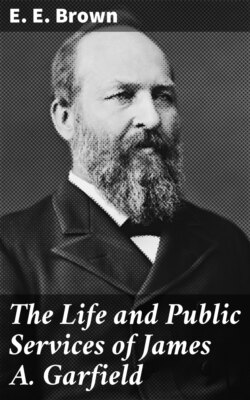Читать книгу The Life and Public Services of James A. Garfield - E. E. Brown - Страница 21
На сайте Литреса книга снята с продажи.
CHAPTER XV.
ОглавлениеTable of Contents
Garfield takes Command of the Twentieth Brigade.—Battles of Shiloh and Corinth.—The fugitive Slave.—Attack of Malaria.—Home Furlough.—Summoned to Washington.—Death of his Child.—Ordered to Join General Rosecrans.—Kirke's description of Garfield.
When Garfield reached Louisville he found that General Buell had hastened on to the assistance of Grant, who was then at Pittsburg Landing. Overtaking General Buell at Columbia, Tennessee, he was assigned to the command of the Twentieth Brigade, and in the famous battle of Shiloh won new laurels.
In the long and wearisome siege of Corinth, Garfield's brigade did signal service; and in June, 1862, they were sent to repair and protect the Memphis and Charleston railroad. Here, as well as at Huntsville, Alabama, Garfield's old skill at carpentry came into play; and he gained no small renown for his fine military engineering.
It was while in the command of this brigade that a fugitive slave came running into his camp, badly wounded and terribly frightened. A few minutes after, his master came riding up, and, with a volley of oaths, demanded his "property." Garfield was not present, so he passed on to the division commander. This man was a believer in the theory that fugitive slaves should be returned to their masters, and that the Union soldiers should see that this was done. He accordingly wrote a peremptory order to General Garfield, in whose command the slave was thought to be hidden, telling him to hunt out the fugitive and deliver him over to his master.
General Garfield took the order and quietly wrote on the back of it—
"I respectfully, but positively, decline to allow my command to search for, or deliver up any fugitive slaves. I conceive that they are here for quite another purpose. The command is open, and no obstacles will be placed in the way of search." When reminded by one of his staff-officers that these rash words might bring him up before a court-martial, he replied—
"The matter may as well be tested first as last. Right is right, and I do not propose to mince matters at all. My soldiers are here for other purposes than hunting and returning fugitive slaves. My people, on the Western Reserve of Ohio, did not send my boys and myself down here to do that kind of business, and they will back me up in my action."
The order was returned with the indorsement unchanged, and nothing more was said about it.
The exposures of the past year, together with the malarial atmosphere of the South, began at last to tell upon the strong physique of the young commander, and he was obliged to take a few weeks' furlough. He had hardly started for home however, when the secretary of war, who had now learned his rare qualities, issued orders for him to relieve General Morgan of his command at Cumberland Gap.
Garfield was too sick to obey, and, a month later the secretary desired him to report in person at Washington, as soon as his health would allow. A new honor awaited him here, for so high an estimate had been placed upon his judgment and his technical knowledge of law that he had been chosen one of the first members in the court-martial of Fitz John Porter.
While at Washington, he was called home by the sickness and death of his eldest child, the "Little Trot," whose simple headstone in the cemetery at Hiram bears the touching inscription—
"She has gained the crown without the cross."
In the following January, Garfield was ordered to join General Rosecrans, then in command of the Army of the Cumberland. It is said that Rosecrans was somewhat prejudiced against Garfield because he had heard of him as a preacher who had taken up politics. A few days' acquaintance however, so thoroughly changed the General's opinion, that he gave Garfield the choice of joining his staff or commanding a brigade. He chose the former, and Rosecrans, writing of him, said—
"I found him to be a competent and efficient officer, an earnest and devoted patriot, and a man of the highest honor."
It is interesting to read just here Edmund Kirke's graphic picture of Garfield, "Down in Tennessee," which was written in 1863.
"In a corner by the window, seated at a small pine desk—a sort of packing-box perched on a long-legged stool, and divided into pigeon-holes, with a turn-down lid, was a tall, deep-chested, sinewy-built man, with regular, massive features, a full, clear blue eye, and a high broad forehead, rising into a ridge over the eyes, as if it had been thrown up by a plough. There was something singularly engaging in his open expressive face, and his whole appearance indicated great reserve power. His uniform, though cleanly brushed and sitting easily upon him, had a sort of democratic air, and everything about him seemed to denote that he was a man of the people. A rusty slouched hat, large enough to have fitted Daniel Webster, lay on the desk before him; but a glance at that was not needed to convince me that his head held more than the common share of brains. Though he is yet young—not thirty-three—the reader has heard of him, and if he lives he will make his name long remembered in our history."
